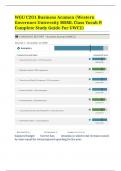Exam (elaborations)
WGU C201 Business Acumen (Western Governors University MSML Class Vocab & Complete Study Guide For UWC2)
- Course
- Institution
WGU C201 Business Acumen (Western Governors University MSML Class Vocab & Complete Study Guide For UWC2)
[Show more]



